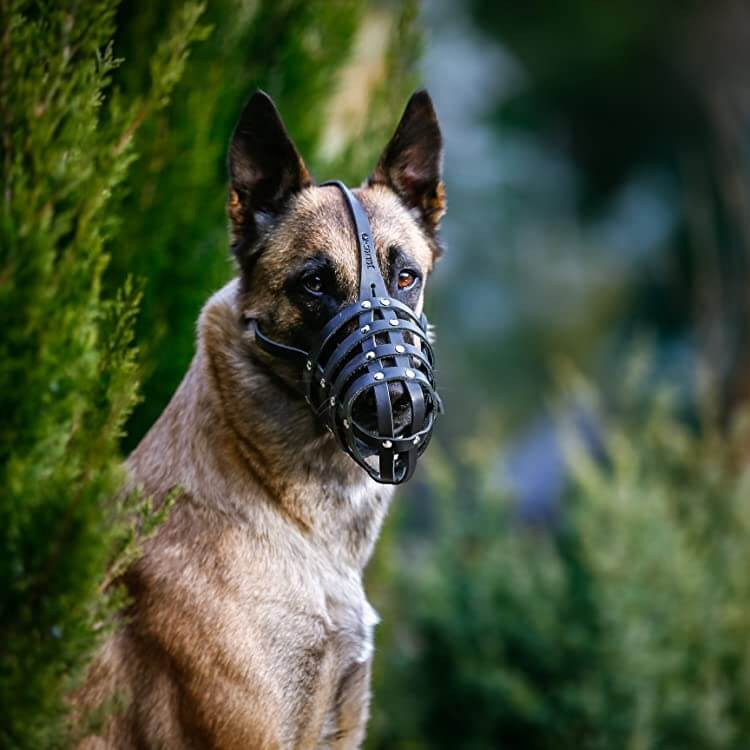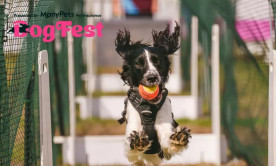For any pet lover the sight of a dog in a muzzle can be heartbreaking but muzzles should be used whenever there is any risk of a bite happening. They are vital in teaching more aggressive dogs bite control or if a dog has had an incident of biting.
Below we outline the basics of getting your dog used to wearing a muzzle.
Introducing your dog to the muzzle
Like any new accessory your dog will wear, it’s very important to take the time and introduce your dog properly to the muzzle. This will get them familiar with it before trying to put it on the first time.
Sight & Smell
First, let your dog sniff the muzzle. This let them get used to its smell and you should reinforce their interest in it by using treats and giving them lots of praise.
Touch
Second, you should get your dog used to the feel of the muzzle. Avoid forcing it over your dog’s snout and let your dog make the first move. Add peanut butter (or their favourite paste type treat) inside the muzzle – this will encourage them to stick their nose in. Be sure to hold up the muzzle up for your dog so they can get right into it.
It’s important not to rush this stage and you should spend some time doing this until you are sure your dog is completely comfortable with the sensation of the muzzle.
Sound
Muzzles in general can have quite a few odd noises for a dog, like the buckle fastener or the creaking of good quality leather. It’s good practice to get your dog used to these strange sounds while doing the Sight, Smell, and Touch stages. This way you further help avoid spooking your dog when you come to attach the muzzle for the first time.
Remember not to force the muzzle over your dog’s face and let your dog always come to the muzzle, otherwise you risk giving them a negative connection to it.
Slow training incorporation
If your dog can’t follow simple obedience commands like sit or heel, then you’ll have a very difficult time getting them used to wearing a muzzle and you should prioritise teaching your dog these basics first.
Incorporating muzzle wearing as part of your everyday training and command routine is important for getting the muzzle normalised for your dog. Use the treat reinforcement touch technique above, the aim is to eventually get your dog to come to the muzzle and even voluntarily slip their snout into it on command.
Adding the ‘muzzle’ command
Add some peanut butter or favourite treat into the muzzle, then say your regular commands for sit, stay, heel, or your usual obedience commands, then add the command ‘muzzle’ into your training and offer the treat coated muzzle to the dog. After some rounds of this, your dog should start coming to you.
Building trust
Do not actually lock the muzzle over their face yet as you’re still building trust. Remember you are trying to make this training experience fun and to be like their other everyday commands, so lots of positive reinforcement is needed.
Locking the muzzle
Patience is a virtue with all dog training and you are going to want to take your time with muzzles. Once your dog is used to the feel of the muzzle around their snout, and once you are happy that they are responsive to your commands (which shows they are comfortable with the equipment), you can start getting your dog used to it being full locked on.
The straps
First get them used to the straps. Without fully buckling them, wrap the straps around their head and hold them in place. Repeat this a good few times with positive reinforcement. This should help your dog get a feel of the resting position of the straps once they are fully attached.
Securing the buckle
Now they are used to the straps you can close the buckle to attach the muzzle fully. As soon as the muzzle is fitted, feed them their favourite treats through the muzzle with lots of positive reinforcement.
It’s very normal that your dog will try to paw the muzzle off their face and they may even whimper so don’t panic. When they stop scratching at the muzzle, again reward them with treats.
Taking the muzzle off
After the first few introductions to the muzzle when you take it off do not offer treats. You want all the positivity to be associated with wearing the muzzle – not once it’s off.
Movement and Lead Training
Once they are used to the muzzle being attached get them to walk around with it on. First do this off-lead over short distances, making the dog come to you.
When they are comfortable doing that, attach their lead to a collar or harness. First do this in a private area away from other dogs in order not to distract or overwhelm your dog too much.
Start at a walking pace, occasionally feed treats through the muzzle. Then build up to quicker paces.
If your dog starts to paw at the muzzle try and keep moving to distract them. If you stop every time they attempt to get it off, then you are reinforcing this behaviour.
Important note on muzzle sizing
- Make sure the muzzle is not too loose or too tight.
- You should be able to comfortably slip two fingers under the straps.
- The muzzle should not be pressed against your dog’s nose.
- You dog must have enough room to open their mouths to pant.
For more information: The Blue Cross has an excellent, in-depth, video explaining all aspects of muzzle training here.





